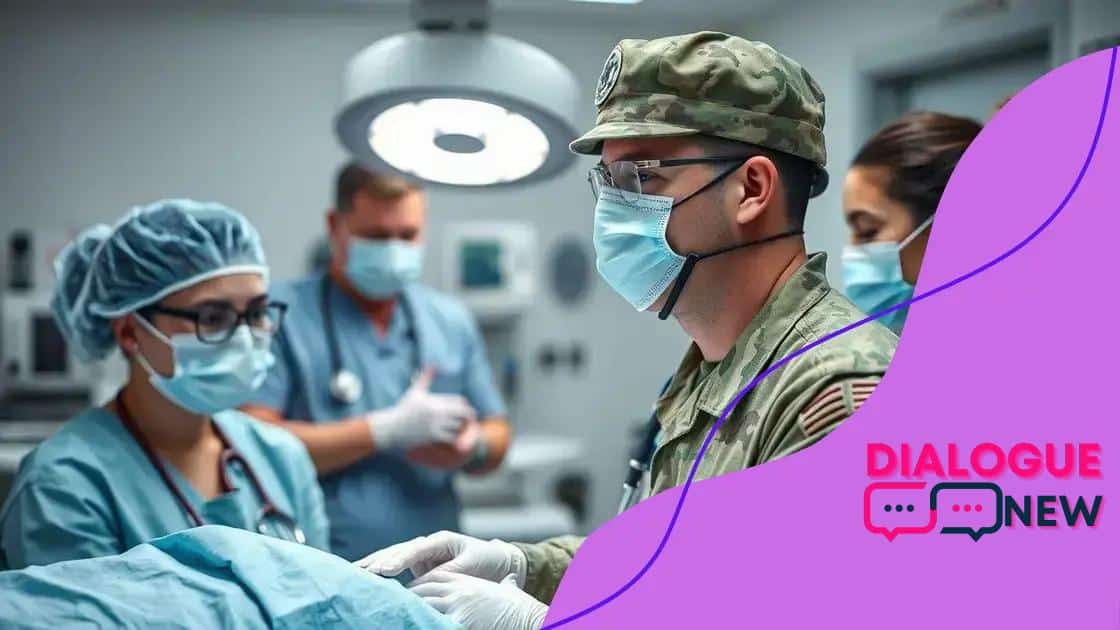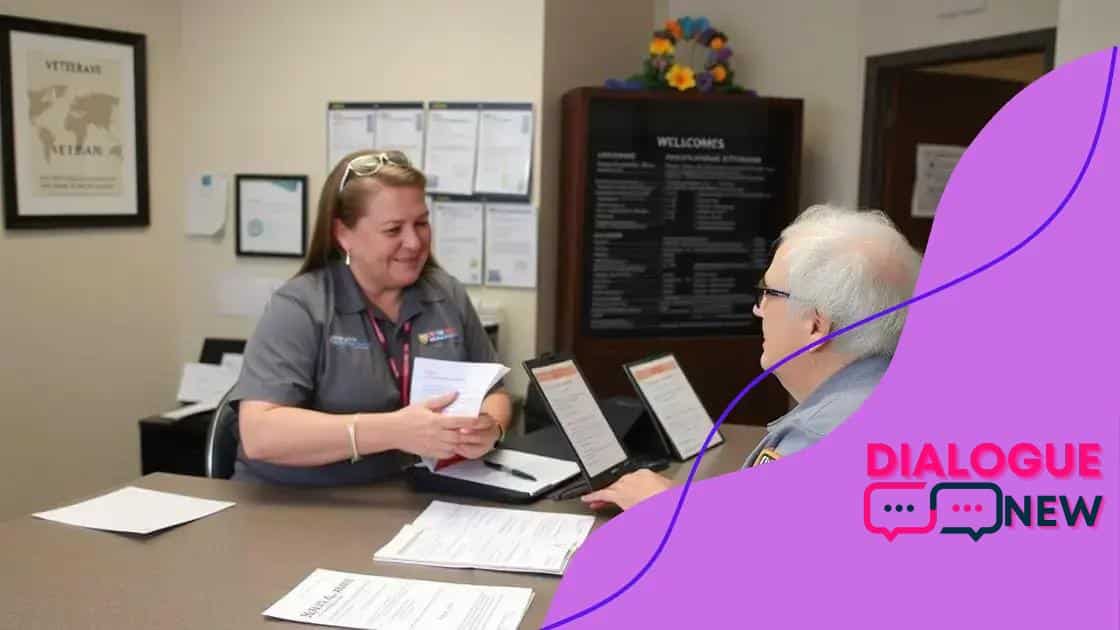Improvements in veterans’ healthcare and benefits matter now

Improvements in veterans’ healthcare and benefits include enhanced telehealth access, greater mental health support, and the integration of technology, all aimed at ensuring veterans receive timely and personalized care.
Improvements in veterans’ healthcare and benefits are crucial for the well-being of those who served. Have you ever wondered how these changes impact their lives? Let’s delve into the latest updates and what they truly mean.
Understanding veterans’ healthcare systems
Understanding veterans’ healthcare systems is essential for ensuring that those who served our country receive the care they deserve. The system is designed to provide comprehensive health services tailored specifically for veterans, addressing their unique needs.
The main framework of the system includes various components such as hospitals, clinics, and specialized programs. These facilities play a crucial role in delivering healthcare to veterans, ensuring they can access services when needed.
Key Components of the Veterans’ Healthcare System
These elements come together to form a robust healthcare network. Among the key components are:
- Health care services provided by the Department of Veterans Affairs (VA)
- Community-based outpatient clinics that extend services closer to veterans’ homes
- Programs focused on mental health and substance abuse treatment
- Specialized care for conditions like PTSD and traumatic brain injuries
This extensive network aims to meet a wide variety of health needs, which is crucial for veterans transitioning to civilian life. It helps bridge the gap between military and civilian healthcare.
Challenges in the System
Despite its advantages, the veterans’ healthcare system faces several challenges. Limited resources can affect the accessibility and quality of care. Sometimes, veterans experience long wait times for appointments, which can impact their health outcomes. Additionally, understanding eligibility for various services can be complicated for many.
Efforts are continually being made to improve the experience for veterans. Awareness campaigns, new policies, and funding initiatives strive to enhance the quality of care and streamline access to services.
Strengthening the connection between veterans and the healthcare services available to them is vital. Overall, a deep understanding of how veterans’ healthcare systems work can empower veterans and their families to take full advantage of available resources.
Recent improvements in healthcare services
Recent improvements in healthcare services for veterans have made a significant difference in their overall well-being. These developments are designed to provide better access to care and enhance the quality of treatment.
One of the key improvements includes the integration of technology in healthcare delivery. Veterans can now schedule appointments, access medical records, and communicate with their healthcare providers through user-friendly online portals. This shift has streamlined the process and reduced wait times.
Notable Upgrades in Services
The enhancements encompass various areas within the healthcare system:
- Increased telehealth services, allowing veterans to consult with healthcare professionals remotely.
- Expanded mental health programs to support those dealing with PTSD and depression.
- Improved physical rehabilitation services tailored to veterans’ specific needs.
- Healthcare facilities that are more accessible, featuring new locations and shorter travel times.
These recent changes aim to address the unique challenges that veterans often face. With better access to healthcare, veterans are more likely to seek treatment, leading to improved health outcomes.
Focus on Holistic Care
A growing trend in recent improvements is the focus on holistic care. This approach considers the physical, emotional, and social factors affecting a veteran’s health. By treating the whole person instead of just individual symptoms, healthcare providers can offer more effective solutions. This comprehensive care model is particularly beneficial for dealing with complex issues, helping veterans find stability and support.
Improved collaboration between various healthcare providers also plays a vital role in enhancing services. By working together, different specialties can ensure that veterans receive cohesive care plans tailored just for them. This teamwork is changing the way healthcare is delivered, making it more efficient and effective for veterans.
Benefits veterans can access today

Veterans today can access numerous benefits designed to support their unique needs. These benefits provide vital resources, including healthcare, education, and housing assistance, ensuring veterans can successfully transition to civilian life.
The Department of Veterans Affairs (VA) offers a range of programs focused on different aspects of a veteran’s life. Understanding what is available can help veterans tap into these resources and improve their quality of life.
Healthcare Benefits
Access to healthcare is one of the most crucial benefits for veterans. The VA provides:
- Comprehensive medical care through VA hospitals and clinics.
- Mental health services, including counseling and support for conditions like PTSD.
- Rehabilitation programs for those recovering from injuries or surgeries.
These services are essential to maintaining health and well-being, giving veterans the support they need to manage physical and emotional challenges.
Education and Employment Support
Another significant benefit involves educational resources. Veterans can access:
- Montgomery GI Bill, covering tuition for college, vocational, or technical schools.
- Vocational Rehabilitation and Employment programs for job training.
- Scholarships specifically tailored for veterans returning to school.
These educational benefits help veterans gain new skills and advance their careers, empowering them to succeed in the job market.
Housing assistance is also available, with programs designed to help veterans secure stable living conditions. Options include VA home loans, allowing veterans to purchase homes with favorable terms, and rental assistance programs aimed at reducing housing costs.
Overall, the variety of accessible benefits enables veterans to lead fulfilling lives. By utilizing these resources, they can overcome challenges, enhance their well-being, and contribute to society effectively.
Challenges faced by veterans in accessing care
Veterans often encounter numerous challenges when trying to access healthcare services. These obstacles can hinder their ability to receive the necessary care and support they deserve.
One significant issue is the complexity of the healthcare system itself. Navigating through various programs, benefits, and eligibility requirements can be overwhelming for many veterans. This confusion may prevent them from seeking help, causing delays in care.
Common Barriers to Care
Several barriers impact veterans’ access to healthcare:
- Long wait times for appointments, which can lead to deterioration in health.
- Limited availability of specialized services in certain areas.
- Transportation issues, making it difficult for veterans to reach healthcare facilities.
- Lack of awareness about available benefits and services.
Additionally, veterans with mental health conditions, such as PTSD, may face stigma when seeking help. This stigma can discourage them from discussing their struggles, making it even more challenging to access necessary care. There is also the issue of continuity in care; if a veteran changes locations, transferring their medical records and establishing new care can be a hurdle.
Efforts to Improve Access
To tackle these challenges, various initiatives are underway. The VA has implemented programs to enhance telehealth services, allowing veterans to receive care from home. These services can reduce travel time and make it easier for veterans to connect with healthcare providers.
Moreover, outreach efforts aim to educate veterans about their benefits and services. By providing clear information, the VA hopes to enable veterans to make informed decisions regarding their healthcare options. These combined efforts are steps toward ensuring that veterans can access the care they need without unnecessary barriers.
Future trends in veterans’ healthcare and benefits
Future trends in veterans’ healthcare and benefits are focusing on innovation and personalization. As new technologies emerge, the way veterans access care and support is changing dramatically.
One major trend is the increasing use of telehealth services. These services make it easier for veterans to receive care without needing to travel long distances. With telehealth, appointments can be conducted via video calls, allowing for greater flexibility and convenience.
Incorporating Technology
Another trend is the incorporation of wearable technology and health apps. These tools enable veterans to monitor their health in real-time, providing important data to healthcare providers. This information can help in creating personalized treatment plans that cater to individual needs.
Furthermore, the use of artificial intelligence in healthcare is on the rise. AI can assist in diagnosing conditions and predicting health outcomes, making the healthcare process more efficient. By analyzing data, AI systems can help identify trends and suggest preventive measures tailored to veterans.
Enhancing Access to Care
Improving access to care is also a priority for the future. Initiatives are underway to expand service locations and enhance transportation options for veterans. Mobile clinics are being introduced in rural areas, bringing healthcare directly to those who need it most. These clinics can address common health issues and provide essential services.
Moreover, there is a growing emphasis on mental health support. Programs are being developed to provide veterans with easy access to mental health resources, ensuring they receive the help they need. Integrating mental health services with primary care can significantly improve overall well-being.
As trends evolve, collaboration among organizations that serve veterans is crucial. By working together, these entities can share resources and information, creating a more cohesive system that benefits all veterans. Overall, the future of veterans’ healthcare looks promising, with a focus on innovative solutions and improved access to care.
In conclusion, the landscape of veterans’ healthcare and benefits is evolving rapidly. Innovations in technology and a focus on personalized care are improving access and quality for those who served. Telehealth services are making it easier for veterans to get help, while wearable technology helps monitor health conditions. Additionally, there is a growing emphasis on mental health support, ensuring that veterans have comprehensive resources available. As we move forward, collaboration among organizations will be key to meeting the diverse needs of veterans, helping them lead healthier and more fulfilling lives.
FAQ – Frequently Asked Questions about Veterans’ Healthcare and Benefits
What innovations are improving veterans’ access to healthcare?
Telehealth services and wearable technology are major innovations that make healthcare more accessible for veterans, allowing them to receive care remotely.
How is mental health support being enhanced for veterans?
There is a growing focus on providing dedicated resources and programs to support veterans’ mental health, including counseling and therapy options.
What role does collaboration play in veterans’ healthcare?
Collaboration among various organizations helps improve resource availability and streamline access to care for veterans, ensuring they receive the support they need.
What are some of the challenges veterans face in accessing care?
Veterans often face barriers such as long wait times, transportation issues, and a lack of awareness about available benefits and services.





